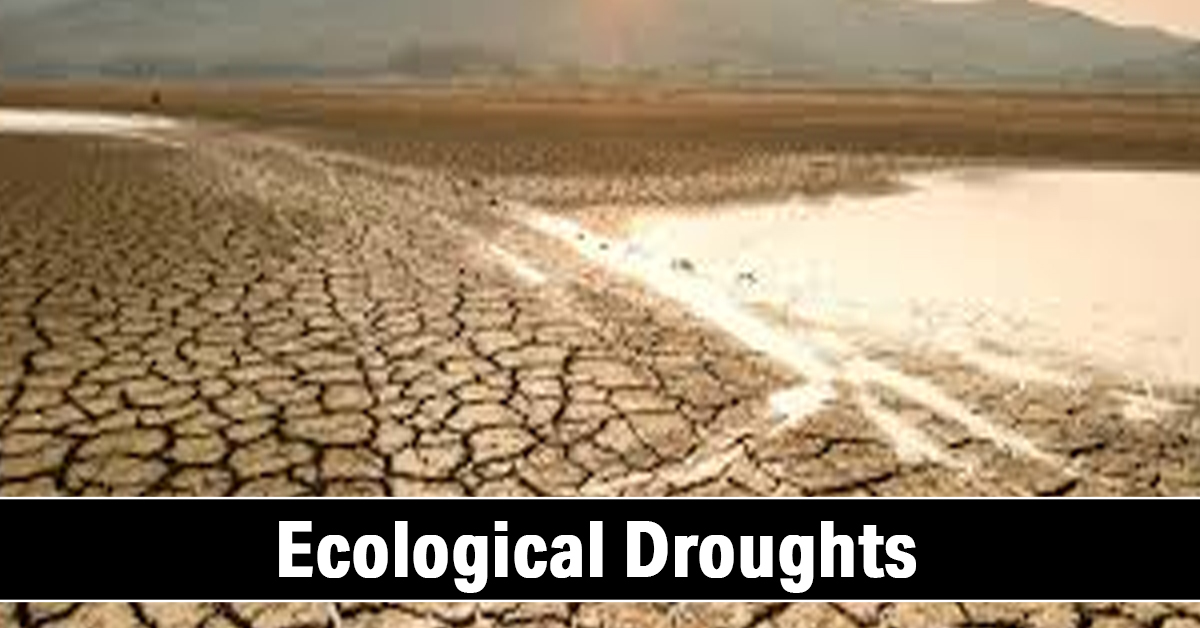Table of Contents
India’s forests, croplands, and river basins are facing a silent but growing climate crisis — ecological droughts. Unlike conventional droughts that affect humans directly, ecological droughts weaken the natural systems that sustain life — forests, crops, soil, and biodiversity.
A recent study by the Indian Institute of Technology (IIT) Kharagpur, published in Nature Communications Earth & Environment, warns that warming oceans, drying air, and deforestation are driving ecological droughts across large parts of India.
If left unchecked, these droughts could transform India’s forests — once major carbon sinks — into carbon sources, worsening climate change.
What Are Ecological Droughts?
Ecological droughts refer to prolonged periods of water deficit that push ecosystems beyond their resilience limits, disrupting:
-
Vegetation growth and greenness
-
Soil moisture and water balance
-
Carbon sequestration capacity
-
Biodiversity and ecosystem stability
Unlike meteorological droughts (lack of rainfall) or agricultural droughts (poor soil moisture), ecological droughts focus on the health of the entire ecosystem, affecting both natural and cultivated landscapes.
Definition (as per IIT Kharagpur study):
“Ecological droughts are prolonged water stress events that disrupt ecosystem structure, function, and services, threatening vegetation health and carbon balance.”
Key Findings: IIT Kharagpur 2025 Study
1. Rising Aridity and Ocean Warming
The study found that between 2000 and 2019, ecological droughts in India were primarily driven by:
-
Meteorological aridity: 23.9%
-
Ocean warming: 18.2%
-
Land evaporative aridity: 14%
-
Atmospheric dryness: 12.4%
Warming oceans are disrupting the Indian monsoon cycle, while rising air dryness reduces vegetation resilience and water retention capacity in soil.
2. India’s Forests at Risk
Ecological droughts are severely affecting forests in:
-
South-western & eastern Himalayas
-
Northeast India
-
Central India
-
Western Ghats
These are India’s key carbon sink regions.
Prolonged stress, reduced moisture, and rising temperatures are causing “vegetation browning” — a decline in plant health visible in satellite imagery.
If trends continue, these forests may emit more carbon than they absorb, worsening global warming.
3. Agricultural Stress and Crop Loss
Croplands across eastern Indo-Gangetic Plains (IGP) and southern India show browning during the monsoon season — a direct impact of warming-induced soil moisture stress.
This not only reduces crop yields but also threatens food security in one of the world’s largest agrarian economies.
4. Human Pressures Amplify Ecological Droughts
Population growth between 2000–2019 increased by 40–60% in ecologically sensitive regions such as the Himalayas, IGP, and Western Ghats.
Consequences include:
-
Deforestation and habitat fragmentation
-
Urban sprawl into forested regions
-
Decline in forest landscape integrity
-
Over-extraction of groundwater
The Indo-Gangetic Plains now have the lowest forest integrity in India due to intense human activity.
5. Shifting Monsoon Patterns
The study observed a westward shift in the Indian Summer Monsoon (ISM) — meaning that rainfall is decreasing in eastern and southern India.
This shift could exacerbate vegetation droughts in the already moisture-stressed regions.
“Rising ecological droughts due to enhanced aridity, ocean warming, and human interventions drive vegetation browning during the monsoon,”
said Rahul Kashyap, lead author of the study.
Regions Most Affected by Ecological Droughts
| Region | Ecosystem Type | Impact |
|---|---|---|
| Western Ghats | Evergreen forests | Severe vegetation stress, forest browning |
| Eastern Himalayas | Mountain forests | Carbon sink weakening |
| Central India | Mixed forests & croplands | Soil moisture loss, degraded ecosystems |
| Northeast India | Rainforests | Declining forest integrity, biodiversity loss |
| Indo-Gangetic Plains | Croplands | Warming-induced soil drought, yield decline |
Over half of India’s 24 river basins are now at high risk of vegetation drought, especially those dependent on monsoon-fed systems.
Ecological Consequences
The cascading effects of ecological droughts are far-reaching:
-
Weakened Carbon Sinks – Forests absorb less CO₂, increasing atmospheric greenhouse gases.
-
Tree Mortality – Rising temperatures and low moisture cause carbon starvation and hydraulic failure.
-
Reduced Agricultural Output – Water stress lowers yields of rice, wheat, and pulses.
-
Biodiversity Loss – Altered habitats disrupt pollination, migration, and species survival.
-
Hydrological Imbalance – Reduced vegetation cover impacts rainfall feedback cycles.
If unchecked, ecological droughts could trigger a climate–vegetation feedback loop, where reduced forest health further weakens the monsoon — creating a self-reinforcing drought cycle.
Policy Implications and Recommendations
The study calls for integrating ecological drought adaptation into India’s climate and sustainability planning.
Key recommendations include:
1. Drought-Resilient Ecosystem Management
-
Identify drought hotspots through remote sensing and AI.
-
Promote reforestation with native drought-tolerant species.
-
Strengthen watershed management in vulnerable zones.
2. Sustainable Land Use and Agriculture
-
Promote climate-smart farming and crop diversification.
-
Encourage agroforestry to combine tree and crop benefits.
-
Limit deforestation and urban encroachment on natural ecosystems.
3. Early Warning Systems
-
Establish an Ecological Drought Monitoring Network.
-
Integrate soil moisture, vegetation index, and climate data for early alerts.
4. Community and Policy Integration
-
Support community-based forest management.
-
Involve Panchayati Raj Institutions and NGOs in ecosystem restoration.
-
Link National Forest Policy with National Action Plan on Climate Change (NAPCC) for coordinated action.
5. Invest in Research and Education
-
Enhance climate resilience research on ecosystem thresholds.
-
Promote ecological literacy to make sustainability a grassroots priority.
Conclusion
India’s ecosystems are standing at a tipping point.
The IIT Kharagpur study highlights that warming oceans, atmospheric dryness, and human interference are intensifying ecological droughts, threatening both biodiversity and carbon stability.
Protecting forests and croplands from this growing menace requires urgent, science-based adaptation strategies that blend traditional knowledge, technological innovation, and sustainable governance.
If India acts now, it can safeguard its ecosystems and ensure that its forests remain carbon sinks, not carbon sources — a crucial step in combating global climate change.


 Securities Markets Code Bill 2025: Towar...
Securities Markets Code Bill 2025: Towar...
 Weakly Interacting Massive Particles (WI...
Weakly Interacting Massive Particles (WI...
 India–Oman Trade Deal: CEPA Signed to ...
India–Oman Trade Deal: CEPA Signed to ...

























